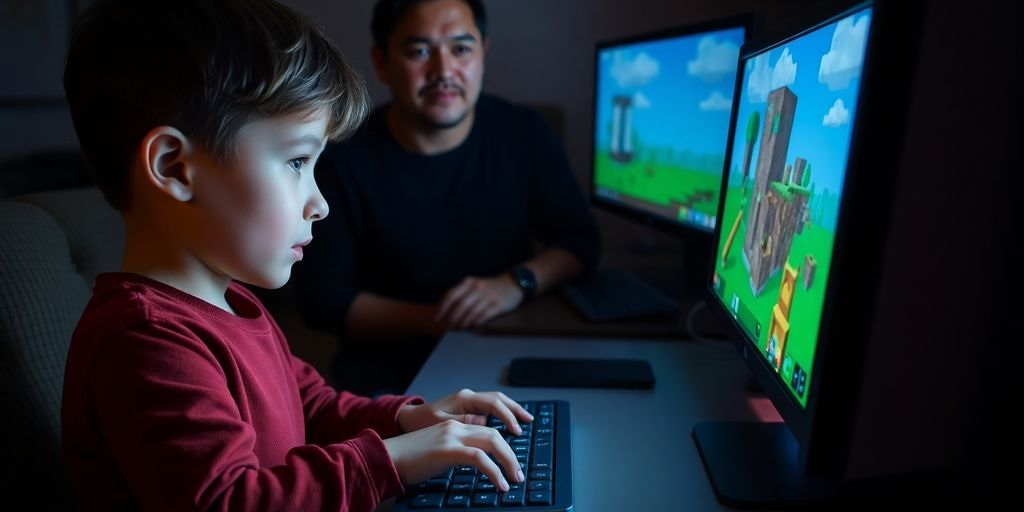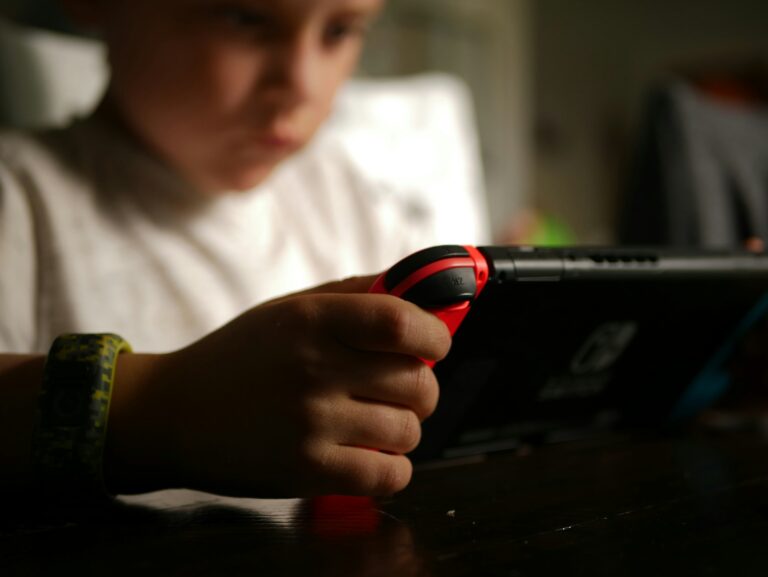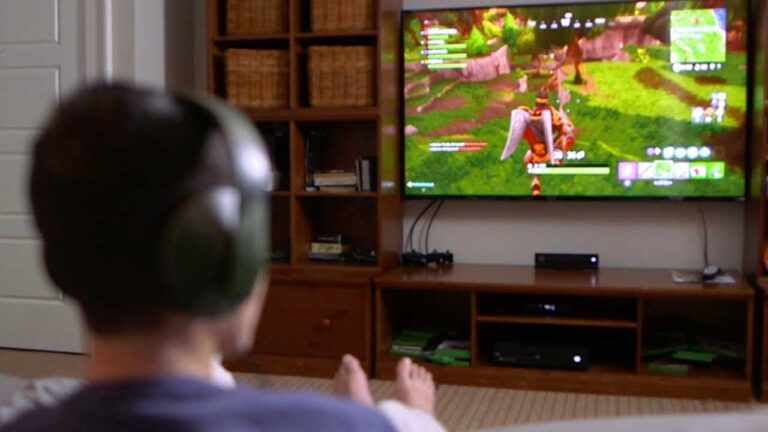
It’s a big problem, this whole Minecraft thing. Lots of parents are seeing their kids get totally hooked, and it’s not just a little bit. We’re talking about real Minecraft addiction, where the game takes over everything. It’s tough to watch, and even tougher to deal with. This article is going to look at why this happens and what it means for kids and families.
Key Takeaways
- Minecraft is designed to be super engaging, almost too much so, making it hard for kids to stop playing.
- Playing too much Minecraft can really mess with a kid’s head, their schoolwork, and even their body.
- Kids who are wired a bit differently, like those with ADHD or autism, might get stuck on Minecraft even more easily.
- The way Minecraft is advertised makes it seem harmless, but the reality is it can cause serious problems for kids.
- Some folks are even taking legal action against the game’s makers because they think the game is designed to be addictive.
Understanding Minecraft Addiction

The Psychology Behind Minecraft’s Allure
Okay, so what’s the deal with Minecraft? Why do kids get so hooked? It’s not just random. The game is designed to grab attention and keep it. Think about it: there’s always something to do, something to build, some new area to explore. This constant stream of possibilities is a big part of what makes it so appealing. It’s like a digital playground that never closes. The open-world exploration captivates millions of players.
Engineered Dependency in Gaming
It’s not a stretch to say that some games are designed to be addictive. Minecraft is no exception. The game uses reward systems, like unlocking new items or completing challenges, to keep players engaged. These rewards trigger the brain’s pleasure centers, making players want to keep playing for that next hit. It’s a cycle that can be hard to break, especially for kids whose brains are still developing. It’s like the designers know exactly what buttons to push to keep players glued to the screen.
The Role of Dopamine in Gaming Addiction
Dopamine, dopamine, dopamine. We hear about it all the time, but what does it really do? In simple terms, it’s a neurotransmitter that plays a big role in pleasure and reward. When kids play Minecraft and achieve something, their brains release dopamine, making them feel good. This feeling reinforces the behavior, making them want to play more. Over time, this can lead to a dependency where they need that dopamine hit to feel normal. It’s a powerful chemical, and games like Minecraft know how to use it.
It’s important to remember that not everyone who plays Minecraft will become addicted. However, understanding the psychological factors at play can help parents and caregivers recognize potential problems and take steps to prevent them.
The Impact of Minecraft Addiction on Children

Mental Health Consequences of Excessive Gaming
It’s easy to see how too much Minecraft can mess with a kid’s head. Spending hours in the game can lead to anxiety and depression, especially when real-life stuff gets ignored. Social isolation is a big problem too. Kids might ditch their friends and family to spend more time building virtual worlds, which isn’t healthy. It’s like they’re choosing the game over everything else, and that can really mess with their emotional well-being. Minecraft can be therapeutic, but it’s important to understand the therapeutic benefits and potential risks.
Cognitive Harm from Prolonged Play
Too much Minecraft isn’t just about feeling down; it can also affect how kids think. Research shows that excessive gaming can mess with attention spans and problem-solving skills. It’s like their brains are getting rewired to focus on the game’s rewards instead of real-world challenges. This can lead to trouble in school and difficulty concentrating on anything that isn’t Minecraft. The constant stimulation can be overwhelming, making it harder for them to focus on tasks that require sustained attention.
- Reduced attention span
- Impaired decision-making
- Difficulty with memory
It’s important to remember that kids’ brains are still developing. Overloading them with constant stimulation from video games can have long-term effects on their cognitive abilities.
Physical Health Problems Linked to Minecraft
It’s not just mental and cognitive health that suffers; physical health takes a hit too. Sitting for hours playing Minecraft can lead to all sorts of problems. Eye strain is common, and so are repetitive stress injuries from using the mouse and keyboard. Kids might also neglect their hygiene and nutrition, opting for quick snacks instead of proper meals. And let’s not forget the lack of sleep, which can affect everything from their mood to their immune system. It’s a whole package of unhealthy habits that can add up over time. It’s important to recognize Minecraft addiction symptoms early on.
- Eye strain and headaches
- Carpal tunnel syndrome
- Poor posture and back pain
Disproportionate Harm to Vulnerable Groups
It’s becoming clear that not all kids are affected equally by potential Minecraft addiction. Some groups are at a much higher risk, and it’s important to understand why. Neurodivergent children, especially those with ADHD or autism, can be particularly vulnerable to the game’s addictive qualities.
Neurodivergent Children and Minecraft’s Design
Minecraft’s open-ended nature and lack of clear stopping points can be a real problem. For kids who already struggle with impulse control, this can make it incredibly hard to step away. The game’s reward system, while fun for many, can become an unhealthy obsession for some neurodivergent children. It’s like the game is specifically designed to exploit certain vulnerabilities.
Hyperfocus in ADHD and Minecraft
ADHD often comes with challenges in maintaining attention, but it can also bring periods of intense focus, sometimes called hyperfocus. Minecraft can easily trigger this. A child might start building something and then spend hours completely absorbed, losing track of time and neglecting other responsibilities. This isn’t just about having fun; it can seriously disrupt their daily life. It’s important to consider video game addiction lawsuits when design choices disproportionately affect children.
Autism Spectrum and Repetitive Game Mechanics
Many individuals on the autism spectrum find comfort in routine and repetition. Minecraft offers plenty of opportunities for this, from mining the same resources over and over to building identical structures. While this can be calming and enjoyable, it can also lead to rigid patterns of behavior and difficulty adapting to changes or interruptions. It’s a fine line between a healthy interest and an unhealthy fixation.
The real issue is that Minecraft, like many games, wasn’t designed with these specific vulnerabilities in mind. It’s not about blaming the game entirely, but recognizing that certain design elements can have a disproportionately negative impact on certain groups of children. We need to push for more inclusive and responsible game design that considers the needs of all players.
Minecraft’s Deceptive Marketing and Realities
Minecraft is often presented as a safe, educational game that encourages creativity and collaboration. However, this image can mask a more concerning reality. The game’s design incorporates elements that can be particularly engaging, and potentially addictive, for children.
Branding Versus Reality in Minecraft
The marketing around Minecraft often emphasizes its educational value and creative potential. Parents might see it as a digital version of building blocks, a safe space for their kids to explore and create. But the reality can be quite different. The open-ended nature of the game, while appealing, can also lead to excessive play and difficulty disengaging. The lack of clear stopping points and the constant stream of rewards can make it hard for children to regulate their playtime. It’s easy to lose track of time when you’re constantly striving to build something bigger or explore a new area. This disconnect between the perceived benefits and the actual experience is a key issue.
The Bedrock Edition and Increased Accessibility
The introduction of the Bedrock Edition in 2017 significantly expanded Minecraft’s reach. By enabling cross-platform play, Microsoft made the game accessible on a wider range of devices, including phones, tablets, and consoles. This increased accessibility meant that Minecraft became a constant presence in many children’s lives. It’s now easier than ever for kids to jump into the game whenever they have a spare moment, further blurring the lines between playtime and other activities. This constant accessibility can make it even harder for parents to set boundaries and manage their children’s gaming habits. The seamless integration across devices has turned Minecraft into a pervasive element of daily life, potentially embedding addictive behaviors. The Minecraft behavior problems linked to its addictive qualities are a growing concern.
Minecraft Addiction Symptoms in Children
Recognizing the signs of potential Minecraft addiction is crucial for parents. Some common symptoms include:
- Social withdrawal: Spending less time with friends and family in favor of playing Minecraft.
- Irritability: Becoming easily frustrated or angry when interrupted during gameplay or when asked to stop playing.
- Academic struggles: A decline in school performance due to lack of focus and time spent on the game.
- Physical health problems: Issues like eye strain, headaches, and repetitive stress injuries from prolonged play.
It’s important to remember that every child is different, and not every child who plays Minecraft will develop an addiction. However, being aware of these potential symptoms can help parents identify problems early on and take steps to address them.
It’s also worth noting that the game’s multiplayer modes can expose children to harmful interactions, such as cyberbullying and griefing. While Microsoft has implemented some safety measures, these may not always be sufficient to protect young players. The addictive gameplay mechanics, such as randomized rewards, open-ended play, and microtransactions, can make it difficult for children to disengage, leading to addiction.
Legal Actions Against Minecraft’s Creators
Allegations of Exploitative Design
There’s a growing wave of concern about how Minecraft is designed, with some arguing that its mechanics are intentionally exploitative, especially towards younger players. The core of these allegations is that the game uses features known to be addictive, like randomized rewards and a never-ending world, without putting in place enough protections for kids. It’s like giving a child a bottomless candy jar and expecting them to stop themselves. The argument is that Minecraft’s design prioritizes keeping players hooked, even if it means potential harm.
The Microsoft Minecraft Addiction Lawsuit
Lawsuits are starting to pop up, targeting Microsoft (who now owns Minecraft) and Mojang (the original developers). These minecraft addiction lawsuits aren’t just about individual cases; they’re part of a bigger push to make gaming companies take responsibility for the potential harm their games can cause. Parents are reporting unexpected charges due to in-game purchases, highlighting the financial implications of such purchases. The legal arguments often center around two main points:
- Minecraft is inherently unsafe for children because of its addictive features.
- Microsoft and Mojang failed to warn users about the risks of prolonged play.
- The game lacks natural stopping points, encouraging continuous play.
The lawsuits suggest that Minecraft was designed to maximize engagement at the expense of player well-being. This isn’t just about a fun game; it’s about a system that may be intentionally designed to keep kids playing, regardless of the consequences.
Demanding Accountability from Gaming Companies
These legal battles are about more than just money; they’re about changing how games are made and marketed. The goal is to push for safer, more ethical practices that put the well-being of players, especially children, first. It’s about holding gaming companies accountable for the harm caused by their products and demanding that they prioritize player health over profits. Mojang reportedly paid damages to children with gambling addictions due to in-game purchases, as discussed on Reddit.
Addressing Minecraft Behavior Problems
Lack of Natural Stopping Points in Gameplay
Minecraft, by design, doesn’t have a clear ending. This open-ended nature can make it hard for kids to stop playing. There aren’t any levels to beat or a final boss to defeat, so the game can just keep going and going. It’s like an endless loop, and that’s part of what makes it so engaging, but also so potentially problematic. This lack of closure can lead to extended play sessions and difficulty transitioning to other activities.
Multiplayer Modes and Harmful Interactions
Multiplayer modes in Minecraft can be a mixed bag. On one hand, they allow kids to connect with friends and work together on projects. On the other hand, they can expose kids to negative interactions, like cyberbullying or exposure to inappropriate content. It’s important to be aware of who your child is playing with online and what kind of conversations they’re having.
Here are some potential risks:
- Exposure to inappropriate language or content
- Cyberbullying from other players
- Interactions with strangers
It’s important to remember that not all online interactions are positive. Talk to your child about online safety and what to do if they encounter something that makes them uncomfortable.
The Challenge of Setting Boundaries for Gaming
Setting boundaries for gaming can be tough, especially when Minecraft is involved. Kids can get really invested in their worlds and may resist limits. It’s important to be consistent and clear about the rules.
Here are some tips for setting boundaries:
- Establish clear time limits for gaming.
- Designate specific times for gaming, such as after homework or chores.
- Enforce consequences for breaking the rules.
- Encourage other activities, like sports, reading, or spending time with friends and family.
Conclusion
So, what’s the takeaway here? It’s pretty clear that Minecraft, despite how innocent it looks, can really get its hooks into kids. We’ve seen how it’s built to keep them playing, sometimes at the cost of their well-being. It’s not about blaming the kids; it’s about understanding how these games work and what that means for our families. As parents, it’s on us to be aware and to help our kids find a good balance. It’s not always easy, but knowing what we’re up against is a big first step.
Frequently Asked Questions
Why is Minecraft so addictive for kids?
Minecraft’s design is very clever. It keeps players hooked with its open-ended style, constant rewards, and immersive world. This can make it hard for kids to stop playing, leading to a cycle of always wanting more. It’s like the game is built to make them keep coming back.
What are the mental health problems caused by too much Minecraft?
Spending too much time on Minecraft can really hurt a child’s mental health. They might feel more worried or sad, and their moods can swing a lot. They might also pull away from friends and family, choosing to play the game instead of doing other things.
Are some children more at risk of Minecraft addiction?
Yes, kids who have ADHD or are on the autism spectrum can be more likely to get hooked on Minecraft. The game’s fast pace and constant action can make kids with ADHD hyperfocus, meaning they get so lost in the game they forget everything else. For kids with autism, the game’s repetitive tasks can be comforting, making it hard to stop playing.
How does Minecraft’s marketing hide its true effects?
Minecraft is often shown as a fun, creative game, but this isn’t always true. The way it’s designed can actually trick kids’ brains, making them play more than they should. This can lead to problems like not wanting to socialize, getting easily annoyed, doing poorly in school, and even having physical issues like eye strain.
What is the Minecraft addiction lawsuit about?
There’s a lawsuit against the makers of Minecraft, like Microsoft and Mojang. It claims that they purposely made the game to be addictive, especially for young kids. The lawsuit wants these companies to be held responsible for the harm the game has caused to children and their families.
Why is it hard to control how much a child plays Minecraft?
Minecraft doesn’t have clear stopping points, which makes it hard for kids to know when to quit. Also, playing with others online can sometimes lead to bad experiences like bullying. It’s tough for parents to set rules because the game is designed to keep kids playing without a natural end.






